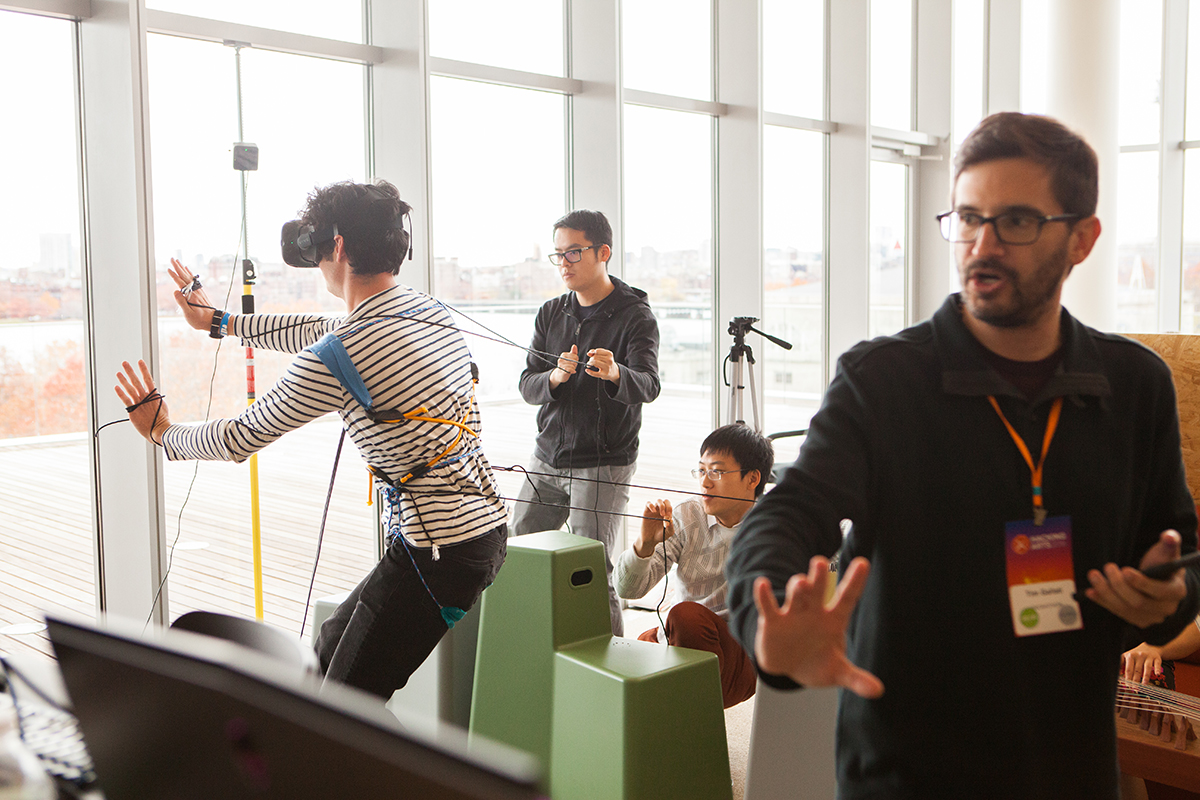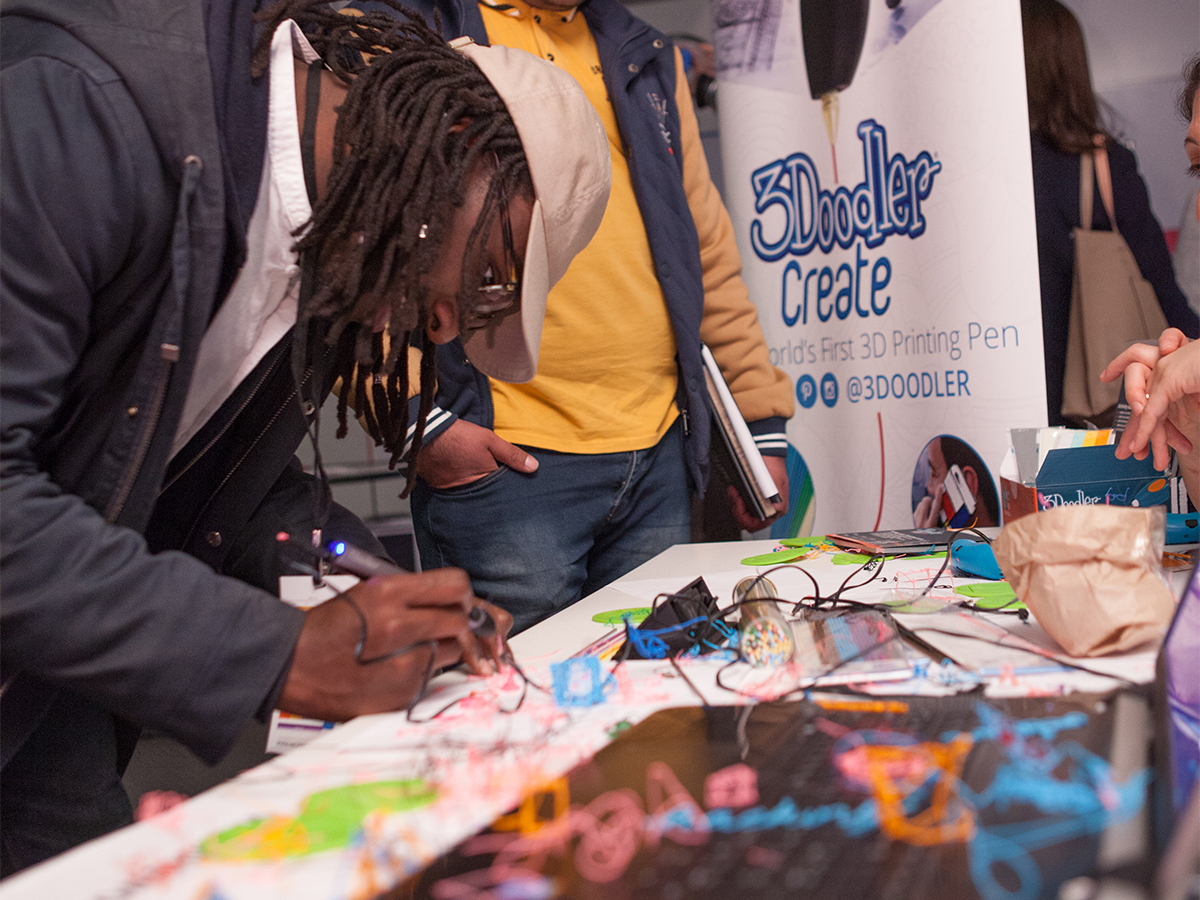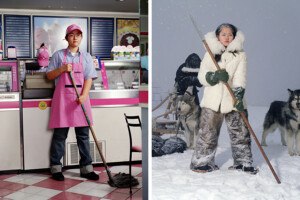MIT’s Fourth Hacking Arts Festival

This year’s Hackathon winners, Team Harmony Space and their prototype that makes it possible to visualize harmonies / Photo by Dana Tarr
“DNA will be our time machine,” said bio artist Joe Davis in a presentation at MIT’s Hacking Arts Festival this past weekend—an oddly meta statement, as it seemed like a method to traverse into or at least glimpse the future was right there at the MIT Media Lab.
On November 19, over 450 artists, entrepreneurs, engineers, designers, and scientists congregated at MIT for the fourth annual installment of the two-day event. Bringing together thinkers, creators, and innovators who inhabit the intersection of art and technology, the festival started with eight panel discussions organized according to fields from dance and music, to bioengineering and fashion . While the topics differed, panelists across the board shared one thing—a hand in the future of art and technology.
Take the first panel, “Play, Perform, Participate,” which considered the titular aspects in relation to public, private, and virtual spaces. LIMINUS, for example, is a performance experience that marries augmented reality gaming (think Pokémon Go) with theater (replace Pikachu with real actors and actresses).
“It’s a half augmented reality game that you play on your phone that leads to performances happening all over streets of Boston and Cambridge,” said panelist and head writer Tau Zaman. By requiring audience members to navigate public spaces, augmented reality (AR) adds another dimension to the world, suspended between real and virtual.
In a similar vein, the “Remixing Our Senses” panel explored augmented and mixed reality technology and its application. Allison Wood, panelist and founder of Reify, a New York-based platform and studio that works with businesses to incorporate AR strategies said, “What’s inspiring to me about AR is the ability to empower people and distribute information. What if I could actually look at a piano and have it tell me how to play it?”
George Fifield, director at Boston Cyberarts, discussed AR as a “guerrilla medium,” with its subversive nature used to make political statements (the AR Goddess of Democracy erected over Tiananmen Square, for instance), and prompted a request from an audience member: “Someone please use AR to subvert the Trump inauguration.”
Another panel, “Biotech and Art,” delved into synthetic biology, bioinformatics, and biotechnology. The panel description was pretty apt: “The future will not be fabricated, it will be grown!”—and possibly in the Amino Lab, founded and directed by panelist Julie Legault. The lab produces home-friendly kits for those without biotech backgrounds to engineer bacteria and produce tangible products such as pigments and dyes.

Team Revive prototypes tactile feedback cues for their tai chi VR experience / Photo by Dana Tarr
The festival took a turn towards the more hands-on portion with the Hackathon, where 38 teams competed to create a prototype of something that “enhances the arts, improves access to the arts, or uses the art.” Mentored by reps from Adobe, Autodesk, Jibo, and other tech giants, the teams presented their creations at the end of the 24-hour event. This year, the winner was Harmony Space, an application that “remaps spatial sense to auditory sense,” making it possible to “hear space and see harmonies” through 3D space-tracking and AR created by Max Harper, Matthew Seaton, and Evin Huggins.
The Tech Expo, held at the List Visual Art Center, showcased 35 companies. There was Hire Notes, a web app created for musicians to streamline bookings (and vice versa), as well as Randori, the world’s first “augmented reality speed climbing game.” Some apps had a more solemn focus, like “Beach,” a project by the Harvard Graduate School of Design that uses virtual reality to visualize the repercussions of climate change, depicting Harvard’s campus 100 years from now, submerged underwater.

3Doodler, the world’s first 3D pen, on show at the Tech Expo / Photo by Dana Tarr
Also in attendance was Jibo, the world’s first social robot, whose abilities range from twerking to telling jokes and reminding you to close the garage door. “Jibo’s a robot with personality and character,” said developer evangelist Justin Woo. “Everyone’s envisioned WALL-E, R2-D2, BB-8—that can’t be done unless we get developers to build applications on him. The reason why we’re here at Hacking Arts is [because] we want everyone to help us create the character of Jibo.”
And that’s precisely what the weekend was—a collaborative effort to not only envision but also to actualize the future.


